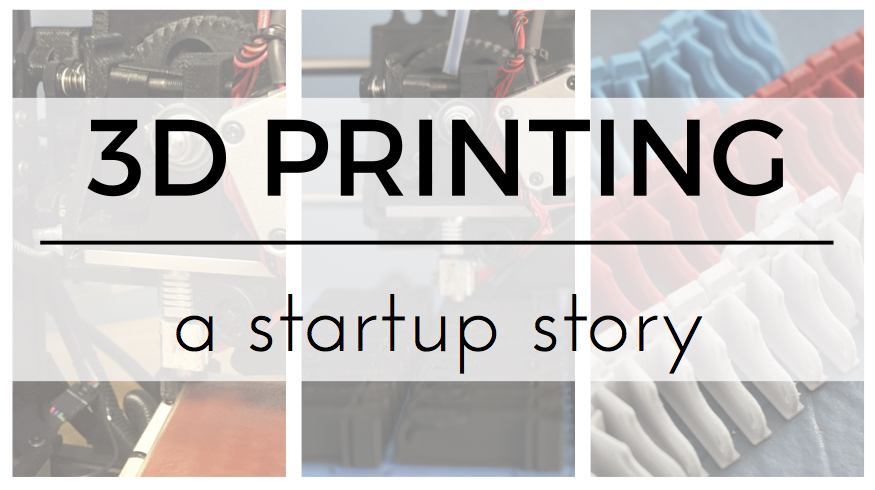So you want to start a 3D Printing Company?
Read Time 5 Minutes
This blog was originally posted at Yale Scientific Magazine and written by John Calloway
Someone said to me recently, “Entrepreneur is just another word for someone who is out of work – you want to be a business owner who is in the field of entrepreneurship!”
In today’s culture, the term “entrepreneur” has become so overused that it has lost its true meaning. The dictionary defines entrepreneur as the following: a person who organizes and operates a business or businesses, taking on greater than normal financial risks in order to do so.
So, you see, at the heart of it, an entrepreneur is a business owner.
Recently, Yale Scientific published an article entitled “3D Printing, Reimagined: which mentioned the idea that “3D printing is still elusive and futuristic.” As a startup company in additive manufacturing, we’ve found this statement to be true. But what others may find challenging is actually an opportunity for a 3D printing startup. Because the industry is so new and still “elusive,” this makes it the perfect timing to jump in and help shape the future of additive manufacturing.
While 3D printing has been around for 30 years, the cost until recent time has been out of reach to the point where the everyday person or even small companies could not afford it. This is another example of how the technology became perceived as intangible. However, in recent times big brand names and start-ups have focused in the construction and creation of 3D printing technology, primarily the printers themselves. This has opened the market to not only large industry members, but to consumers and small businesses alike. One could argue that today, the biggest factor in purchasing a 3D printer or the supporting hardware and materials is not based on cost, but rather your need. With competitive prices and limitless options, you could decide to print art or print hardware or even both and all these options would be roughly in same price range!
But if you want to do it—that is, enter the market of online printing–and be successful, you need to do it right. Setting up in your basement or garage is fine, but if you have a plan and focus, you shouldn’t be staying there long.
With this in mind, I want to share with you some of the processes, challenges and ups and downs that I have encountered and experienced over the last 10 years of starting ideas that turned into companies, running companies that failed, but ultimately following a business model to build a successful company that is growing rapidly in the field of 3D printing. This process applies to any start-up ventures—and in an age when technological innovations are opening countless product opportunities, these steps are key to ensure that science finds an outlet in new markets.
There is no set formula to success- anyone can tell you that and I am sure you have heard it hundreds of times. However, there are systematic steps you can take to formulate and grow your ideas into a well run and successful company. When forming any company or entrepreneurship endeavor, be it with partners or a solo approach there are some general rules I have followed:
- Find your focus – Because 3D printing is so new, the possibilities are really endless. Do you want to do small run-offs? Do you want to do prototypes for the next big Kickstarter campaign? Do you want to specialize in the medical field?
- Create an action plan – I can’t stress this enough. It’s what gives your company vision and direction. A good action plan will aways outline immediate action you can take. For example: We will contact 600 engineer firms in the next 3 months, meeting with 50 of them and close deals on 5 of them.
- Always be learning – It’s been said that if you read at least two books in your industry every month, you will become an expert in that industry. This gives your business value over your competitors.
As a side note: I suggest having at least one partner as it really helps relieve stress and allows for the “bouncing” of ideas back and forth.
A few years ago a friend and I had followed these steps to pursue our idea for an aerospace company. Here’s what our focus looked like: “The company is focusing on aerospace consulting with the long term goal on R&D with alternative propulsion methods while lowering the cost of commercial space travel.”
When we first started Halo Technologies, we were all over the place whether it be sending people to space, web design, online marketing, video production or 3d printing.
It wasn’t until we hammered out a plan and focused on one product (3D Printing) that our business exploded. That brings us to having a solid plan.
Creating a business plan is arguably the most time consuming of the steps and to some, the most difficult. When you are setting up your business and have ideas, there is a temptation to implement all of them at once, but that is certainly the quickest way to fail. It is great to have quick action, but too much at once is going to stunt growth. Limit your approach to a few, even one, solid idea or product and run with that. Build upon this base as able. This is where your innovation and optimizing come into play.
Tip: Check out “The Lean Startup” by Eric Ries. It’s a fantastic read, with case studies on having a solid plan and not growing too quickly in the wrong ways.
I will close with these few comments: Don’t be afraid to do work yourself, but know that it is okay to have others help or work for you. As you grow or have opportunities to work in new areas, you will need help and may have to hire, contract or sub out work. One of the best lessons I’ve learned in business is asking for help. Don’t be afraid to do this. You’d be surprise how many people say yes.
Promote your company both locally and globally. Social media is a great resource for small startups. Don’t underestimate your friends or family and local institutions such as schools, universities and your community. We’ve had several people contact us simply through a LinkedIn blog post.
Always reevaluate what your goals were, what you have achieved and what your future goals may be. Don’t be afraid to alter or adjust according to current trends, financial standings or technology shifts, but never compromise or give up.
3D printing is probably one of the most exciting industries to be a startup in because of its infancy. It gives the beginners of today the opportunity to become the experts of tomorrow. There is no better time to become a part of the 3D printing community and even start your own 3d printing company. The story of 3D printing provides a powerful example of how, with focus and vision, ordinary people can claim a space in the widening world of science and technology.
Move forward purposefully or fall forward accidentally, but never stay in the same place or go back to where you have been.
Author Bio: John Calloway is the owner and president of Halo Technologies, located in West Palm Beach, Florida which specializes in 3D Printing. He loves all things engineering and aerospace and dreams of one day making space travel affordable.

